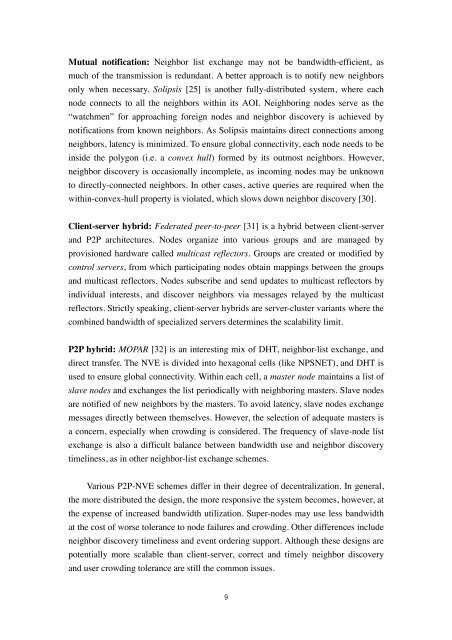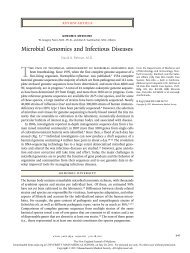A Scalable Peer-to-Peer Network for Virtual Environments - Evernote
A Scalable Peer-to-Peer Network for Virtual Environments - Evernote
A Scalable Peer-to-Peer Network for Virtual Environments - Evernote
Create successful ePaper yourself
Turn your PDF publications into a flip-book with our unique Google optimized e-Paper software.
Mutual notification: Neighbor list exchange may not be bandwidth-efficient, as<br />
much of the transmission is redundant. A better approach is <strong>to</strong> notify new neighbors<br />
only when necessary. Solipsis [25] is another fully-distributed system, where each<br />
node connects <strong>to</strong> all the neighbors within its AOI. Neighboring nodes serve as the<br />
5B'$.C@706+ 1%8+ approaching <strong>for</strong>eign nodes and neighbor discovery is achieved by<br />
notifications from known neighbors. As Solipsis maintains direct connections among<br />
neighbors, latency is minimized. To ensure global connectivity, each node needs <strong>to</strong> be<br />
inside the polygon (i.e. a convex hull) <strong>for</strong>med by its outmost neighbors. However,<br />
neighbor discovery is occasionally incomplete, as incoming nodes may be unknown<br />
<strong>to</strong> directly-connected neighbors. In other cases, active queries are required when the<br />
within-convex-hull property is violated, which slows down neighbor discovery [30].<br />
Client-server hybrid: Federated peer-<strong>to</strong>-peer [31] is a hybrid between client-server<br />
and P2P architectures. Nodes organize in<strong>to</strong> various groups and are managed by<br />
provisioned hardware called multicast reflec<strong>to</strong>rs. Groups are created or modified by<br />
control servers, from which participating nodes obtain mappings between the groups<br />
and multicast reflec<strong>to</strong>rs. Nodes subscribe and send updates <strong>to</strong> multicast reflec<strong>to</strong>rs by<br />
individual interests, and discover neighbors via messages relayed by the multicast<br />
reflec<strong>to</strong>rs. Strictly speaking, client-server hybrids are server-cluster variants where the<br />
combined bandwidth of specialized servers determines the scalability limit.<br />
P2P hybrid: MOPAR [32] is an interesting mix of DHT, neighbor-list exchange, and<br />
direct transfer. The NVE is divided in<strong>to</strong> hexagonal cells (like NPSNET), and DHT is<br />
used <strong>to</strong> ensure global connectivity. Within each cell, a master node maintains a list of<br />
slave nodes and exchanges the list periodically with neighboring masters. Slave nodes<br />
are notified of new neighbors by the masters. To avoid latency, slave nodes exchange<br />
messages directly between themselves. However, the selection of adequate masters is<br />
a concern, especially when crowding is considered. The frequency of slave-node list<br />
exchange is also a difficult balance between bandwidth use and neighbor discovery<br />
timeliness, as in other neighbor-list exchange schemes.<br />
Various P2P-NVE schemes differ in their degree of decentralization. In general,<br />
the more distributed the design, the more responsive the system becomes, however, at<br />
the expense of increased bandwidth utilization. Super-nodes may use less bandwidth<br />
at the cost of worse <strong>to</strong>lerance <strong>to</strong> node failures and crowding. Other differences include<br />
neighbor discovery timeliness and event ordering support. Although these designs are<br />
potentially more scalable than client-server, correct and timely neighbor discovery<br />
and user crowding <strong>to</strong>lerance are still the common issues.<br />
)
















